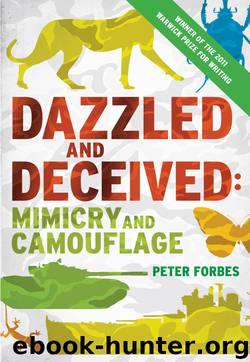Dazzled and Deceived by Peter Forbes

Author:Peter Forbes
Language: eng
Format: epub
ISBN: 9780300125399
Publisher: Yale University Press
Such concern for the maintenance of the agricultural cycle, even on a dummy airfield in wartime, is peculiarly touching. But, out in the brutal world, France fell two months after this memo was written and for five years lights in the fields of France would come to mean spy drops and the Resistance, and the only airfields would be German ones.
Back in England, the decoys were successful, the night dummies more so than the day. By the end of 1941, the 100 night-dummy landing strips had received more than 350 attacks. During the Battle of Britain, from June to October 1940, they absorbed twice as many attacks as the real airfields. But in December 1940 a map retrieved from a shot-down German plane revealed that most of the day dummy sites had been rumbled by the Germans – only three were marked as genuine. In the last quarter of 1941 even the night sites received only one attack, and by May 1942 the scheme would be abandoned.
Meanwhile Cott was finding the Advisory Committee increasingly frustrating. Although services officers such as Wilkinson attended, they withheld information on the grounds that this committee was essentially a civil defence matter. In March 1940 Wilkinson fobbed the committee off with the excuse that he ‘did not know to what extent he could divulge details of camouflage progress’.
Cott was then cheered up by the arrival, on 28 March, of printed copies of his book; but on 5 April he wrote to Anderson tendering his resignation from the committee: ‘I am wasting my time.’ The committee was a sop, not the real thing. Stymied at home, Cott began to wonder if Palestine or Egypt might offer better pickings. Both Cott and Kerr were outraged at the feeble attempts at camouflage then being perpetrated and campaigned to increase public awareness.
Cott's bid for attention was a long unsigned piece published in Nature on 22 June 1940. The article poured scorn on the rash of ‘camouflage’ that was hastily being rolled out: the familiar lozenges of brown, khaki and grey. Large factory installations such as cooling towers had trees painted on them, as if that would, even remotely, function as concealment when seen from a bomber plane: ‘the result of light and shade is such as absolutely to kill this piece of stage scenery at bombing range’. Despite the obvious falsity of the muddy lozenge school of camouflage, Cott realised that ‘so consistently has this method been adopted by the authorities that the term “camouflage” has come to mean parti-colouring with drab colours’.
Cott poured especial derision on the camouflaging of London's 5,000-strong bus fleet:
The roofs of many double-decked buses have now been treated with grey or green and brown; but the front, back and sides – the parts most visible in oblique view from the air – are coloured a brilliant red – the very hue the chief attribute of which is its carrying power and conspicuousness.
Download
This site does not store any files on its server. We only index and link to content provided by other sites. Please contact the content providers to delete copyright contents if any and email us, we'll remove relevant links or contents immediately.
Sapiens: A Brief History of Humankind by Yuval Noah Harari(14216)
Sapiens by Yuval Noah Harari(5281)
Pale Blue Dot by Carl Sagan(4886)
Homo Deus: A Brief History of Tomorrow by Yuval Noah Harari(4801)
Livewired by David Eagleman(3663)
Origin Story: A Big History of Everything by David Christian(3631)
Brief Answers to the Big Questions by Stephen Hawking(3357)
Inferior by Angela Saini(3260)
Origin Story by David Christian(3132)
Signature in the Cell: DNA and the Evidence for Intelligent Design by Stephen C. Meyer(3055)
The Gene: An Intimate History by Siddhartha Mukherjee(3029)
The Evolution of Beauty by Richard O. Prum(2925)
Aliens by Jim Al-Khalili(2776)
How The Mind Works by Steven Pinker(2714)
A Short History of Nearly Everything by Bryson Bill(2616)
Sex at Dawn: The Prehistoric Origins of Modern Sexuality by Ryan Christopher(2472)
From Bacteria to Bach and Back by Daniel C. Dennett(2432)
Endless Forms Most Beautiful by Sean B. Carroll(2414)
Who We Are and How We Got Here by David Reich(2385)
